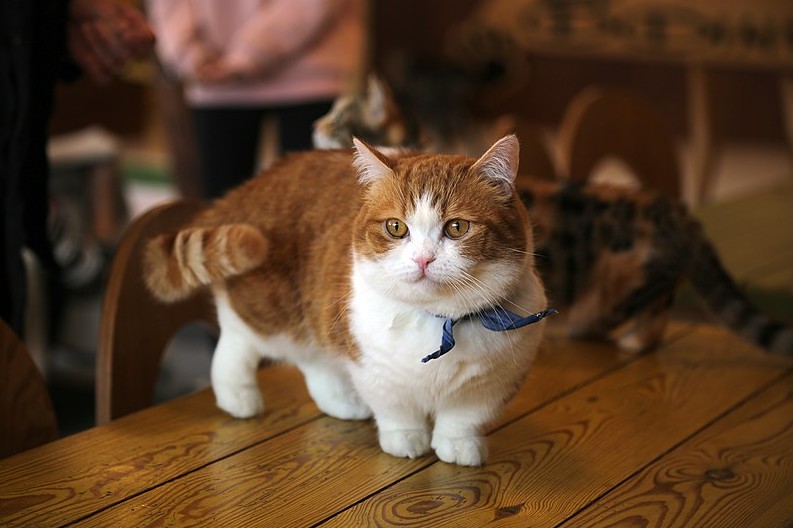Renowned for their short legs, Munchkin cats are not a crossbreed with a Dachshund and a feline, as their low-riding look is a product of natural genetic mutation. Despite their size, these cats are never meager in terms of fun, energy, and playfulness. They climb, take small leaps, or sit back on their buns if something interests their ever-curious minds – never allowing their short stature to hold them back.
Origin of the Munchkin Cat
Short-legged cats have been recorded in England as early in the 1930s. However, the Munchkin breed’s origin traces back around fifty years later when Sandra Hochenedel, a school teacher in Louisiana, found two-short-legged pregnant felines under her car. Sandra brought one of the cats home, which she had called Blackberry.
Blackberry gave birth to a litter, half of them sport the same short-legged structure. LaFrance, Sandra’s friend, received one of the kittens from the litter and named it Toulouse. All cats from the official Munchkin breed are believed to trace their roots from Blackberry and Toulouse.
The two friends soon reached out to TICA (The International International Cat Association) to distinguish if their felines are of a new breed. After a series of tests on their genetic composition, it was found out that these felines’ short legs don’t impose any issues to their spine compared to spinal problems more common in dog breeds with shorter legs.
Soon, the Munchkin made its way to TICA’s televised cat show. However, the breed received different reactions from the viewers. Many raised their eyebrows and contradicted the idea of breeding cats with shorter legs as they deem it would create inconvenience and health problems for the Munchkins. With that, many cat associations also rejected acknowledging the breed. But despite all the opposition, no evidence of physical disadvantages or health problems have come up relating to the breed’s distinct low-riding build.
Physical Characteristics of the Munchkin Cat
Height: 5 to 7 inches
Weight: 5 to 9 pounds
Life Expectancy: 12 to 15 years
Coat Color: Colors, patterns, and shadings vary
Type of Coat: Short or Long
Eye Color: All colors, such as brown, blue, green, copper, and yellow
Munchkin cats are most conspicuous with their short-legs, which come in three different types: standard, super-short, and rug-hugger, with the latter being born with the shortest legs. A natural genetic mutation brings this distinguishable feature. If these litters don’t possess the heterozygous gene, they will be born with normal legs.
These felines’ fur is available in a wide array of colors, patterns, and shadings, and the coat length may either be short or long. The long-haired munchkins have more grooming needs than the short-haired ones.
Munchkin Cat Personality
Munchkin cats are friendly and fun-loving furballs that tend to keep their kittenish demeanor into their adulthood. They are very affectionate and would be happy to cuddle with their owners. Otherwise, they can be seen running fast like ferrets or playing the catnip mouse, keeping the family entertained.
However, these short-legged cats may have a mischievous side, acting like magpies and hoarding shiny stuff for play. If any kitchenware or jewelry is missing, it is best to check their bed as they are most likely the culprits.
Highly curious, Munchkin cats would love to explore and survey their surroundings. They will often sit on their buns like prairie dogs to observe anything that interests them more clearly.
As a sociable breed, they get along with children and other cat-friendly pets. They would be glad to wrestle even with long-legged feline breeds, not minding the difference in their stature. In fact, they are unaware that there is something distinct about them. In their world, they are normal cats who do what typical felines do, such as climbing posts or chairs. However, they may take some fun and scenic routes before getting to where they want.
Caring for the Munchkin Cat
Munchkins cats grooming needs vary depending on their coat style. Weekly brushing would suffice to keep the short-haired munchkins coats tangle and mat-free. However, it requires a few more times a week of brushing to maintain the long-haired munchkins’ coat in its tip-top condition.
Cats usually clean themselves but, it would be hard for these felines to do so given their limited leg reach. With that, bathing them occasionally is an excellent way to keep them clean and healthy alongside regular ear cleaning, nail trimming, and dental brushing.
When it comes to their exercise needs, these furballs may not need much human interventions. They can run and play all day, keeping them in shape and providing the daily exercise requirements they need. Suitable investments would be cat toys, scratching posts, and low cat trees and perches to help them consume their energy. Also blessed with smarts, they can learn fetch or be trained to walk on a leash.
Given their pleasant demeanor, Munchkins are amenable to live with children and cat-friendly pets. However, it is best to socialize them early at a young age, to help both sides feel more comfortable with their relationship.
Quality cat food and fresh water should adequately be provided to keep them healthy. It is advisable to use plates or dishes with lower edges for them to gain easy access. Despite many controversies, Munchkin cats are renowned for being relatively healthy without much prevalent congenital or genetic issues documented to the bred. Regular check-ups with the vet and getting the proper immunizations can help them live a long, happy life.
Munchkins may be short stature but never lacking in the bundles of joy. Despite their size, they are energetic, playful, fast, and blessed with smarts, making a lovely and fun addition to any home and capturing the hearts of their families forever.

